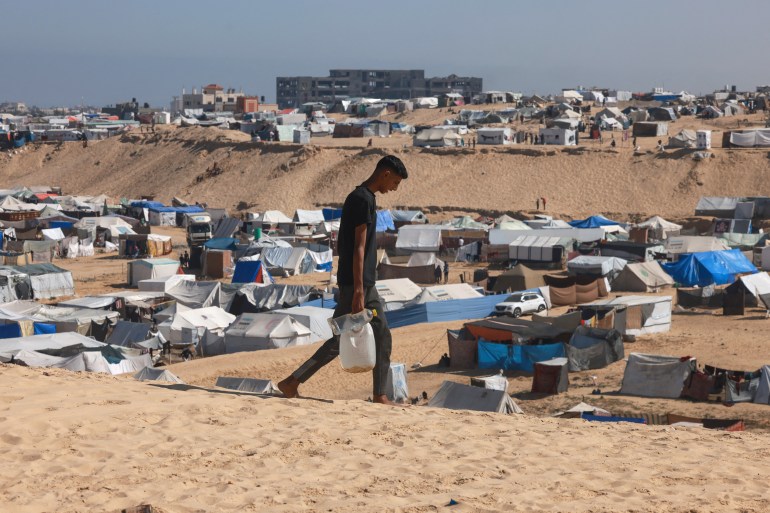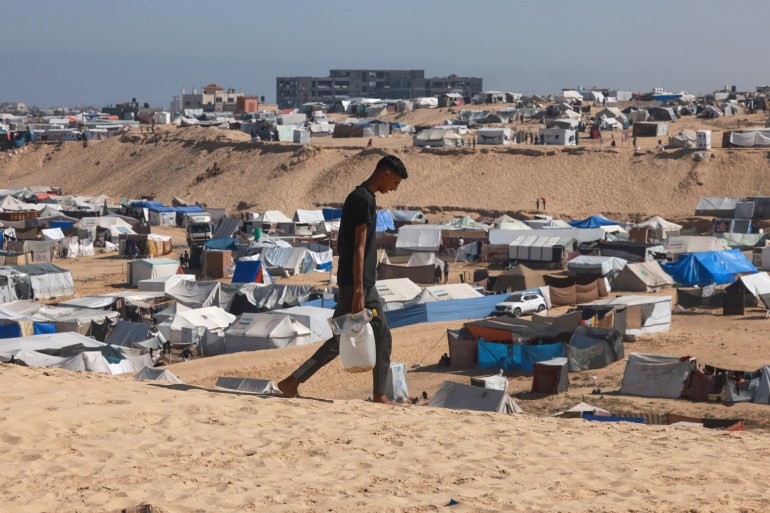After six months of relentless attacks on Gaza, Israel remains no closer to a victory than it has been at any point since October of last year.
Whether it has plans for the enclave beyond the fighting remains unknown, while more than 33,000 people, the majority women and children lie dead.
More than 75,000 people have been injured and most of the population has been displaced.
Some 1.5 million of those displaced are sheltering in the southernmost city of Rafah, whose future remains uncertain in the face of constant Israeli bombardment and threats of a ground invasion.
In the meantime, Israel, which claims that it killed some 12,000 fighters among the tens of thousands of dead, is using their alleged presence to press on.
What does Israel want?
Beyond this assault, what Israel wants in Gaza remains unclear, and there is no Palestinian, international or Israeli consensus on who would administer the enclave in the future.
Israeli forces, dramatically reduced in number from the massive deployment at the beginning of the war – with just one brigade reported to be present in southern Gaza – have struggled to gain and retain control over territory crisscrossed by unknown miles of tunnels that allow Palestinian fighters mobility and access.
Areas such as al-Shifa Hospital, which was stormed for a second time in mid-March after Israeli claims of having searched and cleared it in November.
Among other areas it claimed to have “cleared of terrorists”, the Israeli army has returned to the Zeitoun neighbourhood in Gaza City, the Shati refugee camp and the city of Beit Hanoon, among others.
Hamas fighters, aided by what appears to be a still serviceable tunnel network, which a Western intelligence official told the BBC in February seemed to have only been reduced by a third, have forced Israeli forces into a deadly chase across the enclave.
Current troop numbers stand in stark contrast with the 360,000 reservists mobilised to counter the October 7 Hamas-led attack on Israel, which saw 1,139 people, the majority civilians, killed and 250 taken captive into Gaza.
What can Israel afford?
To return to Gaza in the numbers needed to prove effective would be costly. After the call-up for the initial surge into Gaza, the Israeli economy shrank by 7 percent as the war drew workers from their jobs.
Moreover, the possibility of a fresh front opening on Israel’s northern border with the Lebanon-based group, Hezbollah, with which it maintains a steady exchange of fire, remains a possibility.

Prime Minister Benjamin Netanyahu defines the war aims as defeating Hamas and freeing an unknown number of remaining Israeli captives.
A wartime opinion poll during December’s brief ceasefire suggested an increase in support for Hamas across Gaza, as well as a clear rejection of the West’s preferred candidate to administer any post-war settlement in Gaza: Palestinian Authority leader Mahmoud Abbas.
Israel will probably “face lingering armed resistance from Hamas for years to come, and the military will struggle to neutralise Hamas’s underground infrastructure, which allows insurgents to hide, regain strength, and surprise Israeli forces”, the US said of the situation in its Threat Assessment in March.
“I don’t know if it’s about support for Hamas as much as it is whoever’s striking back,” Baraa Shiban, an associate fellow at the Royal United Services Institute said, referring to Palestinians responding to Hamas as a resistance group rather than a political entity.
Meanwhile, Gaza’s homes and life-saving infrastructure lie in ruins, with 84 percent of Gaza’s healthcare facilities damaged or destroyed, and a lack of electricity and water to operate those that remain, a report by the World Bank said earlier this month.
According to the same report, the cost of the damage inflicted on Gaza was $18.5bn, 97 percent of the combined gross domestic product (GDP) of Gaza and the occupied West Bank in 2022.
“It’s going to cost billions to rebuild,” Boaz Atzili, an associate professor at the American University in Washington, DC, said from southern Israel.
“I don’t sense any appetite for that in Israel. It’s possible that some of the Gulf countries might contribute to that, but they’re going to want to see some kind of lasting political settlement, even if that’s just a technocratic administration, first, so they don’t end up back here again.”
Why would Israel plan Gaza’s future?
There seems to be international consensus that Israel will be involved in one form or another in the future of Gaza, once its assault on the besieged enclave ends.
“There is no real plan for Gaza,” said Baraa Shiban of the Royal United Service Institute (RUSI). “Israel just needed to respond forcefully to the [Hamas-led] attack of October 7th and maintain that narrative, which it’s struggled to do.
“Broadly speaking, political opinion in Israel seems to fall into three categories. Firstly, there’s Netanyahu’s view, which is just to get rid of Hamas and free the hostages.
“Secondly, there are those who would like to occupy and administer Gaza.
“Lastly, there’s a group that would like to apply so much pressure onto the Palestinian population that it just spills out into the Sinai [breaching Egypt’s border].”
Several people in Netanyahu’s government have proposed “plans” for Gaza on “the day after”.
In January, Defense Minister Yoav Gallant published a vague proposal for a US-led multinational group overseeing a civilian administration of a few “Palestinian notables” – likely heads of the powerful families that emerged from the chaos of war.
![People inspect damage and recover items from their homes following Israeli air strikes on April 02, 2024 in Rafah, Gaza. [Ahmad Hasaballah/Getty Images]](https://www.aljazeera.com/wp-content/uploads/2024/04/GettyImages-2132344452-1712055373.jpg?w=770&resize=770%2C513)
Gallant’s plan triggered rival plans from within the cabinet, some proposing the settlement of Gaza, and together muddying the waters, saying as much about Israel’s political unity as the future of Gaza.
In February, Netanyahu published a one-and-a-half-page plan of his own, proposing the complete closure of Gaza’s southern border with Egypt, as well as the overhaul of Gaza’s civil administration and education.
Netanyahu’s plan received intense criticism from other states, including Egypt, the United Arab Emirates and the US.
In the face of the carnage inflicted on Gaza, the mounting humanitarian catastrophe and a looming famine, few plans speak to the reality of the people of Gaza: Most have lost loved ones and face the prospect of famine on top of the physical and psychological ravages of a war that does not seem likely to stop.
“While it’s true that Netanyahu would like to extend the conflict into a forever war,” Atzili continued, “it’s equally true that [Hamas leader] Yahya Sinwar would too. Neither has any interest in facing the consequences of their actions.”
No follow-up poll has been conducted on support for Hamas as Gaza suffered successive rounds of Israeli attacks that have destroyed at least 62 percent of homes, the equivalent to 290,820 housing units, destroyed, with over a million people left homeless, according to the World Bank.
In the meantime, with no way of occupying the enclave, or clear and agreed war aim in sight, Israel will have little choice but to continue its attack upon Gaza, with millions of Palestinians paying the price.
Read More: World News | Entertainment News | Celeb News
Aljazera









